JavaScript concepts every Node developer must master
Node.js has quickly become a standard for building web apps and systems software, thanks to its ability to leverage JavaScript on the back end. Popular frameworks like Express and tools like Webpack contribute to its widespread use. Although competitors like Deno and Bun exist, Node remains the leading server-side JavaScript platform.
JavaScript's multiparadigm nature allows for various programming styles, but it also poses risks like scope and object mutation. The lack of tail-call optimization makes large recursive iterations dangerous, and Node’s single-threaded architecture requires asynchronous code for efficiency. Despite its challenges, following key concepts and best practices in JavaScript can help Node.js developers write scalable and efficient code.
1. JavaScript closures
A closure in JavaScript is an inner function that has access to its outer function’s scope, even after the outer function has returned control. A closure makes the variables of the inner function private. Functional programming has exploded in popularity, making closures an essential part of the Node developer’s kit. Here’s a simple example of a closure in JavaScript:
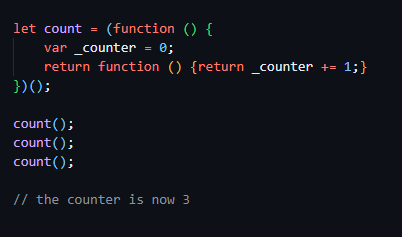
- The variable count is assigned an outer function. The outer function runs only once, which sets the counter to zero and returns an inner function. The _counter variable can be accessed only by the inner function, which makes it behave like a private variable.
- The example here is a higher-order function (or metafunction, a function that takes or returns another function). Closures are found in many other applications. A closure happens anytime you define a function inside another function and the inner function gets both its own scope and access to the parent scope—that is, the inner function can “see” the outer variables, but not vice versa.
- This also comes in handy with functional methods like map(innerFunction), where innerFunction can make use of variables defined in the outer scope.
2. JavaScript prototypes
Every JavaScript function has a prototype property that is used to attach properties and methods. This property is not enumerable. It allows the developer to attach methods or member functions to its objects. JavaScript supports inheritance only through the prototype property. In case of an inherited object, the prototype property points to the object’s parent. A common approach to attach methods to a function is to use prototypes as shown here:
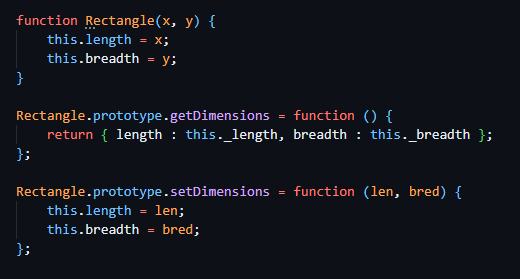
Although modern JavaScript has pretty sophisticated class support, it still uses the prototype system under the hood. This is the source of much of the language’s flexibility.
3. Defining private properties using hash names
In the olden days, the convention of prefixing variables with an underscore was used to indicate that a variable was supposed to be private. However, this was just a suggestion and not a platform-enforced restriction. Modern JavaScript offers hashtag private members and methods for classes:

Private hash names is a newer and very welcome feature in JavaScript! Recent Node versions and browsers support it, and Chrome devtools lets you directly access private variables as a convenience.
4. Defining private properties using closures
Another approach that you will sometimes see for getting around the lack of private properties in JavaScript’s prototype system is using a closure. Modern JavaScript lets you define private properties by using the hashtag prefix, as shown in the above example. However, this does not work for the JavaScript prototype system. Also, this is a trick you will often find in code and its important to understand what it is doing.
Defining private properties using closures lets you simulate a private variable. The member functions that need access to private properties should be defined on the object itself. Here’s the syntax for making private properties using closures:

5. JavaScript modules
Once upon a time, JavaScript had no module system, and developers devised a clever trick (called the module pattern) to rig up something that would work. As JavaScript evolved, it spawned not one but two module systems: the CommonJS include syntax and the ES6 require syntax.
Node has traditionally used CommonJS, while browsers use ES6. However, recent versions of Node (in the last few years) have also supported ES6. The trend now is to use ES6 modules, and someday we’ll have just one module syntax to use across JavaScript. ES6 looks like so (where we export a default module and then import it):
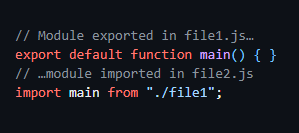
You’ll still see CommonJS, and you’ll sometimes need to use it to import a module. Here’s how it looks to export and then import a default module using CommonJS:

6. Error handling
No matter what language or environment you are in, error handling is essential and unavoidable. Node is no exception. There are three basic ways you’ll deal with errors: try/catch blocks, throwing new errors, and on() handlers.
Blocks with try/catch are the tried-and-true means for capturing errors when things go wrong:
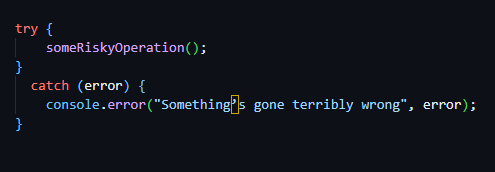
In this case, we log the error to the console with console.error. You could choose to throw the error, passing it up to the next handler. Note that this breaks code flow execution; that is, the current execution stops and the next error handler up the stack takes over:

Modern JavaScript offers quite a few useful properties on its Error objects, including Error.stack for getting a look at the stack trace. In the above example, we are setting the Error.message property and Error.cause with the constructor arguments.
Another place you’ll find errors is in asynchronous code blocks where you handle normal outcomes with .then(). In this case, you can use an on(‘error’) handler or onerror event, depending on how the promise returns the errors. Sometimes, the API will give you back an error object as a second return value with the normal value. (If you use await on the async call, you can wrap it in a try/catch to handle any errors.) Here’s a simple example of handling an asynchronous error:
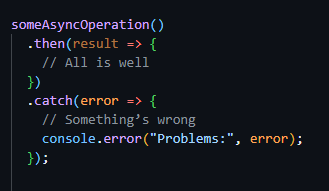
No matter what, don’t ever swallow errors! I won’t show that here because someone might copy and paste it. Basically, if you catch an error and then do nothing, your program will silently continue operating without any obvious indication that something went wrong. The logic will be broken and you’ll be left to ponder until you find your catch block with nothing in it. (Note, providing a finally{} block without a catch block will cause your errors to be swallowed.)
7. JavaScript currying
Currying is a method of making functions more flexible. With a curried function, you can pass all of the arguments that the function is expecting and get the result, or you can pass only a subset of arguments and receive a function back that waits for the remainder of the arguments. Here’s a simple example of a curry:
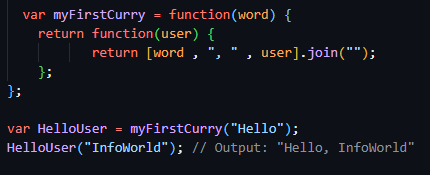
The original curried function can be called directly by passing each of the parameters in a separate set of parentheses, one after the other:

This is an interesting technique that allows you to create function factories, where the outer functions let you partially configure the inner one. For example, you could also use the above curried function like so:

In real-world usage, this idea can be a help when you need to create many functions that vary according to certain parameters.
8. JavaScript apply, call, and bind methods
Although it’s not every day that we use them, it’s good to understand what the call, apply, and bind methods are. Here, we are dealing with some serious language flexibility. At heart, these methods allow you to specify what the this keyword resolves to.
In all three functions, the first argument is always the this value, or context, that you want to give to the function.
Of the three, call is the easiest. It’s the same as invoking a function while specifying its context. Here’s an example:
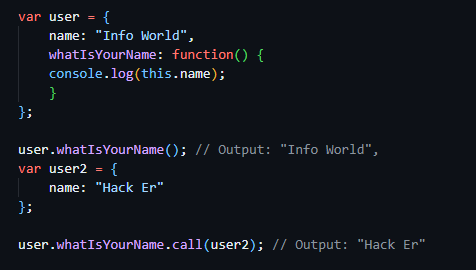
Note that apply is nearly the same as call. The only difference is that you pass arguments as an array and not separately. Arrays are easier to manipulate in JavaScript, opening a larger number of possibilities for working with functions. Here’s an example using apply and call:
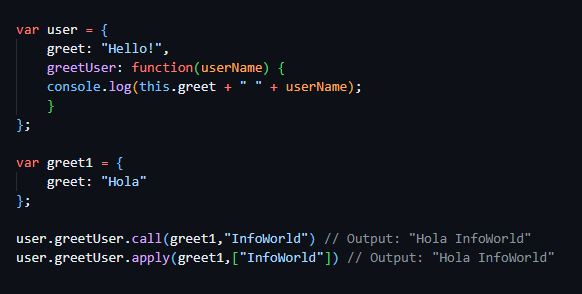
The bind method allows you to pass arguments to a function without invoking it. A new function is returned with arguments bounded preceding any further arguments. Here’s an example:
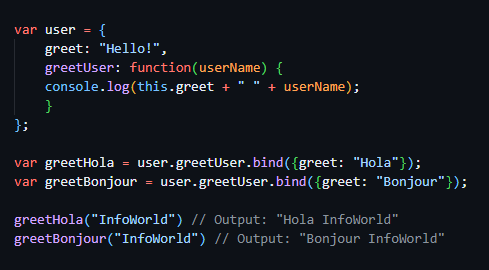
9. JavaScript memoization
Memoization is an optimization technique that speeds up function execution by storing results of expensive operations and returning the cached results when the same set of inputs occur again. JavaScript objects behave like associative arrays, making it easy to implement memoization in JavaScript. Here’s how to convert a recursive factorial function into a memoized factorial function:
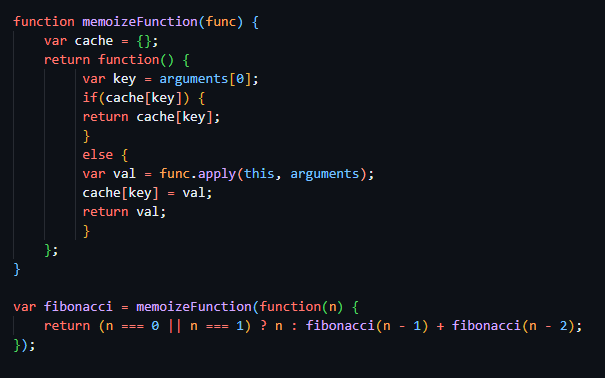
10. JavaScript IIFE
An immediately invoked function expression (IIFE) is a function that is executed as soon as it is created. It has no connection with any events or asynchronous execution. You can define an IIFE as shown here:

The first pair of parentheses function(){...} converts the code inside the parentheses into an expression.The second pair of parentheses calls the function resulting from the expression. An IIFE can also be described as a self-invoking anonymous function. Its most common usage is to limit the scope of a variable made via var or to encapsulate context to avoid name collisions.
There are also situations where you need to call a function using await, but you’re not inside an async function block. This happens sometimes in files that you want to be executable directly and also imported as a module. You can wrap such a function call in an IIFE block like so:
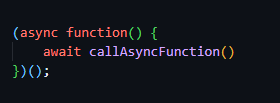
11. Useful argument features
Although JavaScript doesn’t support method overloading (because it can handle arbitrary argument counts on functions), it does have several powerful facilities for dealing with arguments. For one, you can define a function or method with default values:
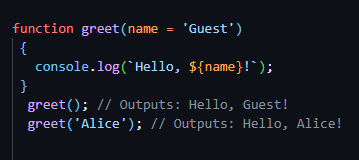
You can also accept and handle all the arguments at once, so that you can handle any number of arguments passed in. This uses the rest operator to collect all the arguments into an array:

If you really need to deal with differing argument configurations, you can always check them:
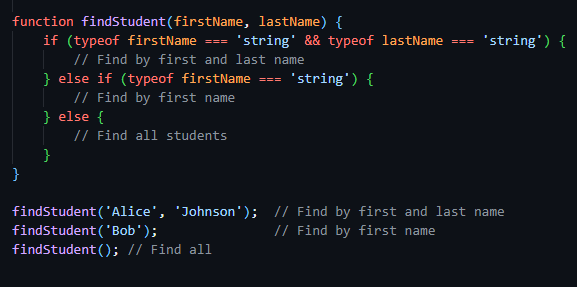
Also, remember that JavaScript includes a built-in arguments array. Every function or method automatically gives you the arguments variable, holding all the arguments passed to the call.
Conclusion
As you become familiar with Node, you’ll notice there are many ways to solve almost every problem. The right approach isn’t always obvious. Sometimes, there are several valid approaches to a given situation. Knowing about the many options available helps.
The 10 JavaScript concepts discussed here are basics every Node developer will benefit from knowing. But they’re the tip of the iceberg. JavaScript is a powerful and complex language. The more you use it, the more you will understand how vast JavaScript really is, and how much you can do with it.
-
 How to Convert a Pandas DataFrame Column to DateTime Format and Filter by Date?Transform Pandas DataFrame Column to DateTime FormatScenario:Data within a Pandas DataFrame often exists in various formats, including strings. When w...Programming Posted on 2025-04-03
How to Convert a Pandas DataFrame Column to DateTime Format and Filter by Date?Transform Pandas DataFrame Column to DateTime FormatScenario:Data within a Pandas DataFrame often exists in various formats, including strings. When w...Programming Posted on 2025-04-03 -
 Which Method for Declaring Multiple Variables in JavaScript is More Maintainable?Declaring Multiple Variables in JavaScript: Exploring Two MethodsIn JavaScript, developers often encounter the need to declare multiple variables. Two...Programming Posted on 2025-04-03
Which Method for Declaring Multiple Variables in JavaScript is More Maintainable?Declaring Multiple Variables in JavaScript: Exploring Two MethodsIn JavaScript, developers often encounter the need to declare multiple variables. Two...Programming Posted on 2025-04-03 -
 How do you extract a random element from an array in PHP?Random Selection from an ArrayIn PHP, obtaining a random item from an array can be accomplished with ease. Consider the following array:$items = [523,...Programming Posted on 2025-04-03
How do you extract a random element from an array in PHP?Random Selection from an ArrayIn PHP, obtaining a random item from an array can be accomplished with ease. Consider the following array:$items = [523,...Programming Posted on 2025-04-03 -
 How to Capture and Stream stdout in Real Time for Chatbot Command Execution?Capturing stdout in Real Time from Command ExecutionIn the realm of developing chatbots capable of executing commands, a common requirement is the abi...Programming Posted on 2025-04-03
How to Capture and Stream stdout in Real Time for Chatbot Command Execution?Capturing stdout in Real Time from Command ExecutionIn the realm of developing chatbots capable of executing commands, a common requirement is the abi...Programming Posted on 2025-04-03 -
 Why Am I Getting a \"Class \'ZipArchive\' Not Found\" Error After Installing Archive_Zip on My Linux Server?Class 'ZipArchive' Not Found Error While Installing Archive_Zip on Linux ServerSymptom:When attempting to run a script that utilizes the ZipAr...Programming Posted on 2025-04-03
Why Am I Getting a \"Class \'ZipArchive\' Not Found\" Error After Installing Archive_Zip on My Linux Server?Class 'ZipArchive' Not Found Error While Installing Archive_Zip on Linux ServerSymptom:When attempting to run a script that utilizes the ZipAr...Programming Posted on 2025-04-03 -
 How Can I Synchronously Iterate and Print Values from Two Equal-Sized Arrays in PHP?Synchronously Iterating and Printing Values from Two Arrays of the Same SizeWhen creating a selectbox using two arrays of equal size, one containing c...Programming Posted on 2025-04-03
How Can I Synchronously Iterate and Print Values from Two Equal-Sized Arrays in PHP?Synchronously Iterating and Printing Values from Two Arrays of the Same SizeWhen creating a selectbox using two arrays of equal size, one containing c...Programming Posted on 2025-04-03 -
 How to Redirect Multiple User Types (Students, Teachers, and Admins) to Their Respective Activities in a Firebase App?Red: How to Redirect Multiple User Types to Respective ActivitiesUnderstanding the ProblemIn a Firebase-based voting app with three distinct user type...Programming Posted on 2025-04-03
How to Redirect Multiple User Types (Students, Teachers, and Admins) to Their Respective Activities in a Firebase App?Red: How to Redirect Multiple User Types to Respective ActivitiesUnderstanding the ProblemIn a Firebase-based voting app with three distinct user type...Programming Posted on 2025-04-03 -
 How Can I Customize Compilation Optimizations in the Go Compiler?Customizing Compilation Optimizations in Go CompilerThe default compilation process in Go follows a specific optimization strategy. However, users may...Programming Posted on 2025-04-03
How Can I Customize Compilation Optimizations in the Go Compiler?Customizing Compilation Optimizations in Go CompilerThe default compilation process in Go follows a specific optimization strategy. However, users may...Programming Posted on 2025-04-03 -
 How to Correctly Display the Current Date and Time in "dd/MM/yyyy HH:mm:ss.SS" Format in Java?How to Display Current Date and Time in "dd/MM/yyyy HH:mm:ss.SS" FormatIn the provided Java code, the issue with displaying the date and tim...Programming Posted on 2025-04-03
How to Correctly Display the Current Date and Time in "dd/MM/yyyy HH:mm:ss.SS" Format in Java?How to Display Current Date and Time in "dd/MM/yyyy HH:mm:ss.SS" FormatIn the provided Java code, the issue with displaying the date and tim...Programming Posted on 2025-04-03 -
 How to Simplify JSON Parsing in PHP for Multi-Dimensional Arrays?Parsing JSON with PHPTrying to parse JSON data in PHP can be challenging, especially when dealing with multi-dimensional arrays. To simplify the proce...Programming Posted on 2025-04-03
How to Simplify JSON Parsing in PHP for Multi-Dimensional Arrays?Parsing JSON with PHPTrying to parse JSON data in PHP can be challenging, especially when dealing with multi-dimensional arrays. To simplify the proce...Programming Posted on 2025-04-03 -
 Why Am I Getting a "Could Not Find an Implementation of the Query Pattern" Error in My Silverlight LINQ Query?Query Pattern Implementation Absence: Resolving "Could Not Find" ErrorsIn a Silverlight application, an attempt to establish a database conn...Programming Posted on 2025-04-03
Why Am I Getting a "Could Not Find an Implementation of the Query Pattern" Error in My Silverlight LINQ Query?Query Pattern Implementation Absence: Resolving "Could Not Find" ErrorsIn a Silverlight application, an attempt to establish a database conn...Programming Posted on 2025-04-03 -
 How Can I Maintain Custom JTable Cell Rendering After Cell Editing?Maintaining JTable Cell Rendering After Cell EditIn a JTable, implementing custom cell rendering and editing capabilities can enhance the user experie...Programming Posted on 2025-04-03
How Can I Maintain Custom JTable Cell Rendering After Cell Editing?Maintaining JTable Cell Rendering After Cell EditIn a JTable, implementing custom cell rendering and editing capabilities can enhance the user experie...Programming Posted on 2025-04-03 -
 How to Fix \"mysql_config not found\" Error When Installing MySQL-python on Ubuntu/Linux?MySQL-python Installation Error: "mysql_config not found"Attempting to install MySQL-python on Ubuntu/Linux Box may encounter an error messa...Programming Posted on 2025-04-03
How to Fix \"mysql_config not found\" Error When Installing MySQL-python on Ubuntu/Linux?MySQL-python Installation Error: "mysql_config not found"Attempting to install MySQL-python on Ubuntu/Linux Box may encounter an error messa...Programming Posted on 2025-04-03 -
 How to Parse JSON Arrays in Go Using the `json` Package?Parsing JSON Arrays in Go with the JSON PackageProblem: How can you parse a JSON string representing an array in Go using the json package?Code Exampl...Programming Posted on 2025-04-03
How to Parse JSON Arrays in Go Using the `json` Package?Parsing JSON Arrays in Go with the JSON PackageProblem: How can you parse a JSON string representing an array in Go using the json package?Code Exampl...Programming Posted on 2025-04-03 -
 How to Resolve \"Refused to Load Script...\" Errors Due to Android\'s Content Security Policy?Unveiling the Mystery: Content Security Policy Directive ErrorsEncountering the enigmatic error "Refused to load the script..." when deployi...Programming Posted on 2025-04-03
How to Resolve \"Refused to Load Script...\" Errors Due to Android\'s Content Security Policy?Unveiling the Mystery: Content Security Policy Directive ErrorsEncountering the enigmatic error "Refused to load the script..." when deployi...Programming Posted on 2025-04-03
Study Chinese
- 1 How do you say "walk" in Chinese? 走路 Chinese pronunciation, 走路 Chinese learning
- 2 How do you say "take a plane" in Chinese? 坐飞机 Chinese pronunciation, 坐飞机 Chinese learning
- 3 How do you say "take a train" in Chinese? 坐火车 Chinese pronunciation, 坐火车 Chinese learning
- 4 How do you say "take a bus" in Chinese? 坐车 Chinese pronunciation, 坐车 Chinese learning
- 5 How to say drive in Chinese? 开车 Chinese pronunciation, 开车 Chinese learning
- 6 How do you say swimming in Chinese? 游泳 Chinese pronunciation, 游泳 Chinese learning
- 7 How do you say ride a bicycle in Chinese? 骑自行车 Chinese pronunciation, 骑自行车 Chinese learning
- 8 How do you say hello in Chinese? 你好Chinese pronunciation, 你好Chinese learning
- 9 How do you say thank you in Chinese? 谢谢Chinese pronunciation, 谢谢Chinese learning
- 10 How to say goodbye in Chinese? 再见Chinese pronunciation, 再见Chinese learning

























